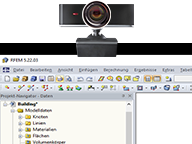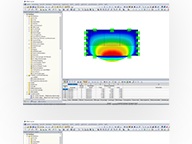Warping Torsion Second-Order Analysis with 7 Degrees of Freedom
RF-/STEEL Warping Torsion | Features
- Applicable for members defined as sets of members
- Separate solver that considers 7 deformation directions (ux, uy, uz, φx, φy, φz, ω) or 8 internal forces (N, Vu, Vv, Mt,pri, Mt,sec, Mu, Mv, Mω)
- Nonlinear design according to second-order analysis
- Input of imperfections
- Calculation of critical load factors and buckling mode shapes as well as the visualization of them (incl. warping)
- Integration into member design in the RF-/STEEL AISC and RF‑/STEEL EC3 add‑on modules
- Available for all thin‑walled steel cross‑sections
RF-/STEEL Warping Torsion | Input
Since RF-/STEEL Warping Torsion is fully integrated in RF-/STEEL AISC and RF‑/STEEL EC3, the data are entered in the same way as for the usual design in these modules. It is only necessary to select the option "Perform warping analysis" in the Details dialog box, tab Warping Torsion (see the figure on the right). You can also define the maximum number of iterations in this dialog box.
The warping torsion analysis is performed for sets of members in RF-/STEEL AISC and RF‑/STEEL EC3. You can define boundary conditions such as nodal supports or member end releases for them.
It is also possible to specify imperfections for the nonlinear calculation.
RF-/STEEL Warping Torsion | Results
The results of warping torsion analysis are displayed in RF-/STEEL AISC and RF-/STEEL EC3 in the usual way. Among other results, the corresponding result windows include the critical warping and torsional values, internal forces, and design summary.
The graphical display of mode shapes (incl. warping) enables a realistic assessment of buckling behavior.
Webshop
Customize your individual program package and find out all the prices online!
Calculate Your Price

The price is valid for United States.






.jpg?mw=1024&hash=e5bfaafe1ee81935e6016a1d264f1f7b0b51471c)




.png?mw=192&hash=f63e4a3f1836233005de32f60201d5392e507cf1)



